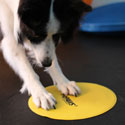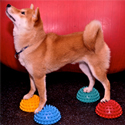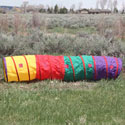Cues as reinforcers
Here's something people often don't get, and not just in agility training: cues—the signals you give your dog to tell it what to do—can be clicks. If your cue tells the dog to do something it understands, and something with a guaranteed positive outcome or reinforcer as a result, it becomes a potential reinforcer in itself. And you can use it to shape behavior.
Let's start with a human example. When you're driving, a green light is a cue to go forward. When the light changes from red to green, you feel glad (a side-effect of positive reinforcement) and you go. That green light not only tells you what to do next, it also reinforces whatever you are doing at the moment. This coincidence actually trains some people, especially new or young drivers, to race the engine or drum their fingers on the steering wheel at red lights. It's not just that they're irritatingly antsy by nature, although that may be true as well. It's also that because the light often turns green while they are doing that particular thing, the action has been reinforced sufficiently to make it recur frequently or even consistently.
An agility run involves a long series of cues about where to go and what to do next. Some are physical cues—turns and moves by the handler— and some are verbal cues: "Tunnel!" "Weave!" "Left!" You have an opportunity to make each of those cues work in your favor by presenting it during (not after) some other behavior that you want to maintain or increase.
Contacts are the obvious example. If, as the dog is traversing the A-frame, you customarily give your cue for the next obstacle or move while the dog is on the contact zone, you reinforce contacts. If you customarily wait until the dog is clear of the obstacle, you reinforce being on the grass or the floor. The dog that usually hears those cues as it steps on the end portion of each obstacle will tend to hit the contacts more often. The dog that usually hears its cues on the ground will aim for the ground and becomes more likely to jump over the contacts. You are playing the laws of averages here. What you click is what you get. The cue is a sort of click, a conditioned reinforcer. The more you use it to reinforce what you like, the more likely you are to get it again.
Agility as a behavior chain
Agility offers a huge opportunity to use cues as reinforcers deliberately. For one thing, the whole experience, if handled efficiently, is one long behavior chain. A behavior chain is NOT a pattern, a previously-learned sequence of behaviors, as many people think: a behavior chain is any series of learned events, linked together by cues, leading to some primary reinforcer at the conclusion, such as a bout of play. This includes novel series in new kinds of sequences; the only requirement to make it work as a chain is that all the elements must be familiar enough to be on cue.
In the agility run, if the handler and dog are really in synch, the flow is seamless: behavior/cue/behavior/cue/behavior/cue and so on until the end: one long chain. Each cue reinforces the current behavior while indicating the next. Since most of the obstacles themselves are fun for the dog, and running is fun too, there are real reinforcers built into the system all the way along, as well as the conditioned reinforcers of the cues. That makes for a very powerful chaining situation, full of reinforcers occurring in unpredictable order. And let's not forget that the dog's successes reinforce the handler's behaviors as well. Both individuals are engaged in a long chain full of varied and hoped-for, but not guaranteed, reinforcers: a downright addictive situation. No wonder agility is so popular.
What doesn't work
Of course if the dog doesn't know or understand the cue, it has no reinforcing ability. Cues have to be built carefully, consistently, and preferably off-course, so you as handler don't get fooled into assuming the dog knows what you mean. Clicker trainer Gary Wilkes recently described an agility handler shouting verbal commands at her dog while the dog was already in the middle of each obstacle. The dog had learned to locate the obstacles by attending to the handler's movements, not her voice. When the handler happened to stand still and yell the cue "right!" the dog was completely at a loss until the handler took off running toward the right.
The message is that you need to know what your cues are. Are you using moves? Fine, just use them consistently and also with appropriate timing, so you make use of their powers as reinforcers. Are you using both moves and verbals? Great, again as long as you know what the dog is really responding to and what is just superstitious behavior on your part (and we all have some, so don't feel bad. I fidget during red lights.)
Cues often lose their reinforcing powers if errors are repeatedly reprimanded or physically "corrected." I've observed this happening at the pause table. The problem begins with the behavior commanded by the word "down." It's a behavior that often has a reinforcement history of a) boring duration and b) "correction" for getting up without permission. Thus the cue word "down" becomes ambiguous in terms of reinforcement. It might lead to permission to move, which is positively reinforcing; it might lead to praise after being let up (and then what are you actually reinforcing?) and it might lead to correction. No wonder some dogs find other things to do when asked to get on the pause table, seem to "forget" what "down" means when they're there, and bounce off before being told to do so.
What's the cure? Well, in my opinion one should never use the same word for lying down on the pause table as for lying down in the house or at obedience class. I might build a "crouch" behavior or "get set" behavior and cue and then both of us would screech to a halt at the pause table, take our "get set" poses, wait, motionless and spring-loaded, for the "green light" moment, and then take off together for the next thrilling obstacle. This constitutes a chain in itself: a cue and behavior for getting on the pause table, a cue and a behavior for the "crouch" or "wait" pose, and a cue and a behavior for jumping down and continuing on the course. Personally I would shape this mini-chain off-course, with clicker and treats, to avoid the pitfalls involved in starting with a previously learned "down" and its cue, and then trying to eliminate mistakes—mistakes that are generated by the reinforcement contingencies, in spite of our perceptions and notwithstanding the dog's willingness to try.
Breaking the chain
So if the big reinforcer comes at the end of the run, and if each obstacle in the run can be a reinforcer in itself, stopping the dog during the run removes further opportunity for reinforcement. So it must constitute a punishment, right? Yes; and sometimes it's the right thing to do nevertheless.
Fear of stopping the run can lead to two common training errors. The first, as I see it, is a determination to run the whole course every time, regardless of mistakes that may happen during the run. This of course means that mistakes get reinforced—the fun continues—and therefore are oh-so-likely to be repeated. However, determination to run the whole course anyway is easy to understand when we reflect that the dog's successes are reinforcing to the handler. Throw in the natural reinforcers generated by exercise—endorphins and increased oxygen and so on—and of course the handler too wants to keep running the course and will give you arguments about why that's the thing to do.
While the whole course constitutes a behavior chain linked together by cues, any portion of the course constitutes a chain as well. An element that is really giving trouble might need to be pulled out of the chain altogether and broken down separately, to isolate and reshape the trouble point. That done, however, smaller chains can be practiced as units. Put together three obstacles and you have a chain. Put together the start, one or two obstacles, and a series of course changes governed by voice and body cues—a couple of crossovers, etc.—and you have a chain. Success can be reinforced with play, or by continuing to another obstacle, or by another cycle through the same mini-chain, or all three. You will minimize accidental breaks in the chain and the resulting punishment not just of the behavior that caused the break but of everything that has gone before. As in obedience, at least in early stages of developing a competitor it might be best that full runs, though fun for all, are a rare event.
What are you actually reinforcing?
Finally, both in agility training and in daily life, we should always keep in mind that cues may be reinforcers. If the cue is a green light toward something the dog wants—if it has been trained positively—then every time you give a cue, you have the opportunity to reinforce what's happening at that moment. As British clicker trainer Kay Laurence recently pointed out in Teaching Dogs magazine, people often use familiar cues to "distract" a dog from doing something they don't want it to do. "Watch me," they say, as the dog bristles at a dog across the street. Dog turns head, click, treat. Make a habit of that…and what are you actually reinforcing? On the other hand, if when the dog checks in with you visually you offer a toy and then play, or say "Sit," and then click and treat—you've successfully used a cue as a reinforcer. The opportunities are endless. The cue as reinforcer is your secret weapon. And it's abundantly available in agility.








I have been thinking about
I have been thinking about using cues as reinforcers myself lately, but whenever I have brought it up to other dog trainers, they don't take me seriously, so it was really nice to read this article, because it's exactly what I have been thinking!
Altho slightly different. I have a 4 month old JRT x puppy, and he knows to come running when I call his name, he also knows 'nooo'. And of course the reward for these is a treat. Come running, get a treat. Stop what you are doing, get a treat.
He does them really well, which is great, but then there are the times when I call him away from one of the cats, he comes running and gets a treat. And what does he do next? He goes right back to annoying the cat, gets called over again, gets a treat. Same thing with 'no', he stops what he's doing, comes running and gets a treat. Then goes right back to what he was doing.
So how do you *really* teach a dog to stop doing something/leave it alone? Obviously any positive word you have taught them is a reinforcer for whatever they are doing, so they will go and do it again.
I love clicker training and I love the idea of making everything fun and exciting for the dog, but I just don't see how you can teach 'leave that alone! forever!' using positive methods.
Agility = FUN! FUN! FUN!
training
I have been training for alot of years. I have trained under the Koeler method. I have changed my thinking when I got involved with JRT's. They are very smart and do not take criticism well! So started reading and doing, and have found that the they learn so much faster and happier. Because of that I can not seem to read enough on this way of training! I am so excited about it I am a little obnoxious about it. Oh Well.
THANK YOU for sharing this with us.
New to training
Ron HansenHi I am new in the training world I have been sucessfull in house training 1 dog (not my own) I will be starting my 2nd dog this week. I am interested in a program where I could learn more about clicker training I have had success with sit, down, stay, recall and loose leash walkng, aong with some tricks. I would like to expand my skills and exeperence to open a training center where I live.
Post new comment